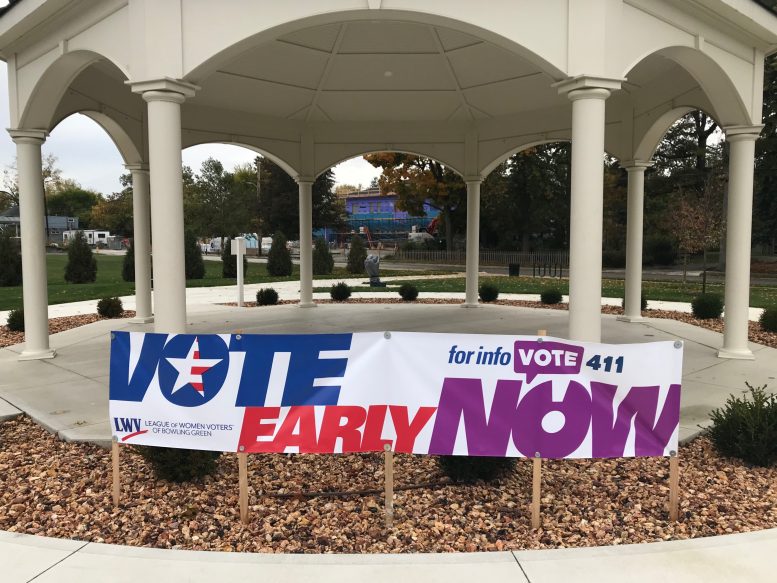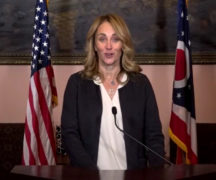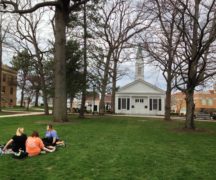Joe Biden is hoping one last push on the penultimate day will break the deadlocked tie.
Donald Trump, focusing his final days elsewhere, is hoping a favorable track record will be enough to give him another Buckeye State win.
Ohio may not be the center of the political universe in 2020, but it remains a place that could mark the difference between presidential victory and defeat.
Polls declare Joe Biden and Donald Trump to be tied in Ohio at an even 46% apiece. In years past, this would mean a flurry of campaigning in Ohio by both candidates in the few weeks leading up to Election Day. There will be one stop here on Monday, with Biden’s campaign announcing he is headed to Cleveland.
For the most part, though, much of the candidates’ last-minute campaigning has targeted other battleground states like Pennsylvania, Michigan and Wisconsin. The contenders have asymmetrical paths to 270 electoral college votes. With polling leads for Biden in numerous Midwestern states — and evidence that Trump 2016 wins like Texas, Georgia, Arizona and North Carolina are in play — the Democrat’s campaign sees paths to victory that do not require winning Ohio. That’s not the case with the incumbent.
“Ohio is required for Trump,” said David Niven, a political science associate professor at the University of Cincinnati. “Ohio is running up the score for Biden.”
Though Ohio is critical to his reelection chances, Trump has only visited here once in the past month. His campaign canceled TV advertising buys here in October and recently relocated a top Ohio advisor to Pennsylvania.
Both Niven and Kyle Kondik, a political analyst for the University of Virginia’s Center for Politics, suggested these decisions reflect the current electoral college landscape.
Ohio went for Trump over Democratic challenger Hillary Clinton by 8 points in 2016. If Trump has to devote major resources and time to Ohio, the two believe, that may spell doom for a number of corresponding states in the Midwest and elsewhere. So Trump is focused elsewhere, seeking to win other tough battlegrounds while hoping Ohio remains in his corner.
“(Trump) needs Ohio so badly he almost can’t afford to fight for it,” Niven said.
The Ohio map
Looking back to four years ago, Niven pointed out the exit polls were brutal for Clinton in Ohio. While women nationwide backed her over Trump by 13%, that margin in Ohio was just 3%. She lost every age group above 29 years old. White voters overwhelmingly supported Trump, including college graduates and non-graduates alike.
“Her loss was not a loss of one thing,” Niven said, “and what made Ohio competitive this year is Biden has very effectively brought back to the fold members of the old Democratic base.”
This includes union households — Biden campaigned at a Toledo union hall a few weeks ago — and white college-educated voters. Biden has also broadened the age range and polls much better than Clinton did among seniors, which Niven said may have in part to do with Trump’s handling of the coronavirus pandemic.
Kondik, an Ohio native who authored “The Bellwether: Why Ohio Picks the President,” said Biden’s better polling among white voters is the big story of the 2020 campaign. This suggests he may fare better in Appalachian parts of the state and in suburbs, where Trump is believed to have lost ground since 2016.
The trouble for Biden, Kondik noted, is an 8% margin from the last election is “a lot of ground to make up.” Kondik said a turnaround like that will require bigger margins toward Biden in population centers like Franklin and Hamilton counties along with making inroads in Trump-leaning counties like Butler, Delaware, Lake and Warren.
What’s the bellwether county of the bellwether state? Kondik has his eye on Wood County in Northwest Ohio, home of Bowling Green State University. This has been a popular campaign stop for candidates in years past; back in 2012, all three presidential contenders visited Bowling Green in a span of a few months.
Reason for Trump optimism
There is some data that points toward Trump carrying the Buckeye State again this year.
Dave Wasserman, a forecaster for the Cook Political Report, recently tracked all of the polling in swing states from the 2016 and 2018 elections. Wassermen looked at how the pre-election polling compared to the actual election results for president, senate and governor.
Some states had barely any difference between the polls and the election results. For most others, the difference was just a few percentage points in either party’s direction.
Of the 12 states tracked, though, Ohio had the biggest margin between polling and eventual results. Wasserman found the election results leaned more than 5% toward Republicans than what polls had indicated.
That trend may not carry into this year’s election. But Wasserman does suggest that Biden may be more likely to “break through” in other toss-up states than in Ohio.
Closing messages
The Trump campaign is emphasizing the economy’s strength before the pandemic hit, with promises that it will rebound again with another term. Such was the major theme at Vice President Mike Pence’s recent visit to Columbus as he spoke in front of workers in hardhats who held signs saying “Jobs! Jobs! Jobs!”
Trump and his surrogates have emphasized the president’s work on trade, the return of college football and the rebuilding of the U.S. military. Trump has touted his response to the pandemic — with help from Gov. Mike DeWine — and believes the country is “rounding the corner,” a contrasting message than the one given by the Ohio Department of Health as this state continues to set new records for cases and hospitalizations.
Biden’s message is often more intangible as he has characterized the campaign as being about the “soul of this nation.” He has talked up his and President Barack Obama’s work to support the auto industry a decade ago.
Biden has also underscored a contrast in his pledged approach to the virus. As Trump has hosted large-scale rallies with no social distancing and few wearing masks, Biden’s in-person events have involved supporters remaining in their cars or sitting apart from one another.
It has been a long presidential campaign season in Ohio, which has involved two debates here, a brief run from Congressman Tim Ryan of Niles and a primary election carried out by mail early on in the pandemic.
In large part because of that pandemic, with many Ohio voters sending in ballots by mail once again, we may not know which candidate won the state for several weeks. Either way, the 2020 election in Ohio looks to be a close one.
***
Also from Ohio Capital Journal:
Bill seeking to prohibit ‘election intimidation’ introduced in Ohio House
A bill regarding election protections was introduced last week by a Democratic Ohio House member.
Though the House won’t come back into session to consider the bill until after the general election, state Rep. Adam Miller, D-Columbus, filed the bill that would bar any “reckless attempts” to force a voter to reveal who they voted for, make false statements, “interfere with an elector in the voting booth,” or destroy or remove a ballot from a polling place, according to the language of the bill.
The bill also includes a clause making it unlawful to “purposely intimidate, threaten, coerce, or attempt to intimidate, threaten, or coerce a person for the purpose of interfering with that person’s right to vote in an election,” the bill states.
Miller said the motivation behind the bill tied in with reports of “unauthorized groups and individuals being called to ‘monitor’ polling locations. This claim was also connected to President Donald Trump, who advised his supporters to “watch very carefully” at the polls. READ MORE
County-by-county COVID-19 response ‘will not work,’ Harvard epidemiologist says
A Harvard epidemiologist cast skepticism on Gov. Mike DeWine’s emphasis on forming “COVID defense teams” to respond to the pandemic on a county-by-county basis.
Dr. Michael Mina, an assistant professor of epidemiology at Harvard University’s T.H. Chan School of Public Health, said a “patchwork approach” of uneven policy applications is doomed to fail.
“As long as we’re doing this in a haphazard, individual district-by-district way, it simply will not work,” he said.
He said the virus pays no attention to political constructs like county lines, and that communities cannot control the virus with an “asynchronous” response — if community A drives case counts down, it’s only so long until community B’s more relaxed approach bleeds over. READ MORE





